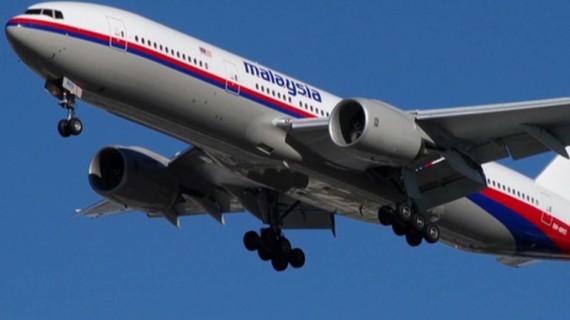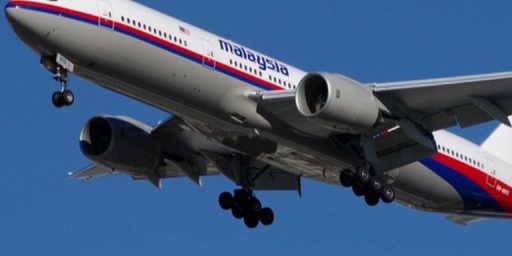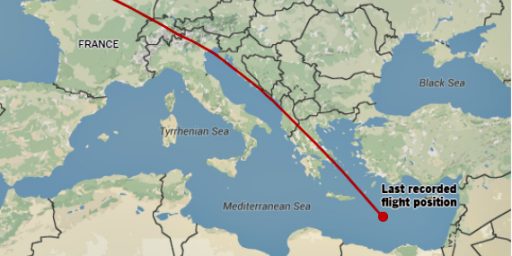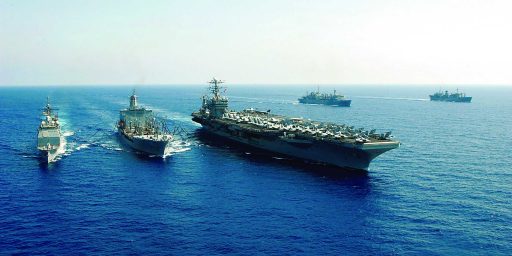Malaysian Air 370 Search Costliest In History
There may be no resolution to what has become the most expensive search in history.
The search for Malaysian Air Flight 370, which disappeared more than a month ago on its way to Beijing, is now the costliest in history:
As the intensive hunt for Malaysia Airlines Flight 370 entered its second month on Tuesday, the only certainty was that it would become the most expensive search and recovery effort in aviation history, with an international fleet of ships and planes scouring the Indian Ocean at a cost of millions of dollars a day.
For the most part, the dozens of countries that have contributed personnel, equipment and expertise to the search have borne the costs while declining to disclose them, with officials offering a united front in saying it would be callous to talk about money while a commercial airliner and the 239 people aboard remained unaccounted for.
On Wednesday, search coordinators reported that an underwater signal had been detected on two occasions the day before, reviving hopes that the Boeing 777-200’s data and voice recorders might be located. The officials warned, however, that they may still be a long way from finding and recovering the plane, and they said they would continue deploying aircraft and ships to search for surface debris.
So, as the hunt wore on, many of the governments involved may soon face a tough decision about whether to keep bearing the extraordinary costs of the search, analysts said.
“Each country will have to ask itself: What are the prospects of further investigation and the cost-benefit of it?” said Ramon Navaratnam, chairman of the Center for Public Policy Studies at the Asian Strategy and Leadership Institute in Kuala Lumpur. “If there’s no prospect, there’s no prospect: We have to be very realistic. But it’s a very difficult decision to make. It’s like someone on a medical support system and you have to determine whether to pull the wires or not.”
Until now, the costliest search and recovery effort ever undertaken followed the crash of Air France Flight 447 hundreds of miles off the coast of Brazil in 2009, reaching about 115 million euros, roughly $160 million at the time, over the course of two years, according to estimates by experts who participated in that effort.
But the search for Flight 370 is already far more complicated, and may have already topped that total. Some of the ships involved cost hundreds of thousands of dollars a day apiece to use, and some of the aircraft being used can cost thousands of dollars an hour each to operate, officials say.
If the current efforts are unsuccesful in finding any evidence of the plane, then it may well be time for the nations involved to recognize that further intensive searching may not be productive use of limited resources. As some have suggested for weeks now, this may end up being one of those aviation mysteries that remains unsolved, if not forever than at least for a very long period of time. That won’t sit well with the families, of course, but when you’re dealing with the equivalent of trying to find a needle in a haystack, there’s really not much more you can do at this point, and we’re nearing the point where it’s largely unrealistic to expect the emergency locator beacons on the voice and data recorders to continue operating given that their batteries are only certified to last 30 days.
At the same time, though, there is some importance to finding the plane, or at least its voice and data recorders, that goes beyond ending this bizarre mystery and providing closure to the families of the passengers or the crew. If there was some mechanical or design flaw in the Boeing 777 that caused what happened, then it’s in everyone’s interest to find out what that is in order to make sure it doesn’t happen again. If this was due to terrorism or some other deliberate act, it would seem important to find out what happened in order to find out what security flaws might have been exploited that we’re not aware of. At the very least, it seems likely that this incident may lead to changes in aircraft design or equipment that would make it easier to keep track of planes on long haul flights like this, or at least make it easier to locate wreckage if something like this ever happens again.
Left unanswered, of course, is what CNN will do with itself when this is all over.






And that all because Malaysia Air saved the $100,000 on the tracker option.
As an aside, it’s been interesting to listen to some of the rampant speculation on this that’s occurred across right wing radio.* In particular the number of different commentators who have repeatedly speculated about the possibility that the plan was hijacked and essentially stolen to use as a 9/11-esque piloted missile at some point in the future.
Not that, given their usual level of hawkishness, one should be surprised how quickly they get worked up over these sorts of Tom Clancy/Action Movie type scenarios. Though, it is telling that they are so ready to believe this, but can’t even imagine the possibility that something like AGW *might* be real.
* – I don’t watch much TV, so I don’t know how much of this sort of speculation has been happening on the news networks.
@Matt Bernius:
My contribution to pure-speculation is that the pilot may have committed suicide – beyond that I, like most sane non-right-wing-radio people, have no idea what happened.
Circumstantial evidence informs my speculation that the United States knows within much more narrow constraints where the plane went down, but can’t say because that would require talking about how they know.
When the two destroyers USS Pinckney (DDG-91) and USS Kidd (DDG-100) were moved into the Indian Ocean somewhat early in the search, they weren’t sent there on a hunch. The US Navy had definitive information. Where did they get it?
Most likely are the two NRO/NSA assumed “Advanced Orion/Mentor” SIGINT satellites in geosynchronous orbit positioned at 95.5º E (USA-171) and 100.9º E (USA-223). The ACARS “pings” would very likely have been picked up by both of them, allowing for triangulation of source. Those satellites are estimated to have collection dish antennas in excess of 100 meters in diameter. While the United States acknowledges the existence of those satellites, their mission naturally is classified and not spoken of.
It’s also likely that one or both of the US destroyers also detected the “pingers” on their sonar systems. Given all the reports about how it was important to get the specialized sonar gear on site, once the plane was known to be on the bottom of the sea, letting on that either DDG had found it would let on to specific detection capabilities of their sonar – at variance with the reported need for the specialized gear.
I’m not the only one speculating that way…
There are certain locations in the oceans where ships and airplanes disappear without a trace. Reports of magnetic interference, unusual weather, and other strange conditions have been documented. This may or may not have happened here, but is just as good as any other theory that has been presented .
And the coverage on CNN has gone over and beyond. Those two guys have been in that simulator for how many days?
You don’t like the timing arcs? I like conspiracy theories but I’m going with unlikely that sekret ELINT birds supplied the solution. There’s too much traffic on the inmarsat contention slot uplink to make it worth capturing from up there 24×7 when you can just listen to the transponder output from the comfort of your sekret ground facility.